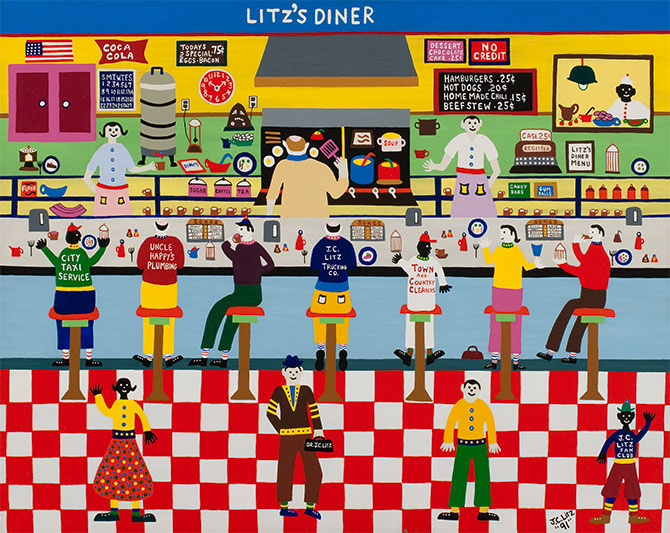Not So Primitive
by Jack Foran

James C. Litz’s paintings at the Burchfield Penney
In his art, James C. Litz made a better world than he found. The world he found was notably that of the Vietnam War.
Post-war readjustment didn’t come easy. He tried alcohol, but that didn’t help much. What did help, ultimately, was painting, which he took up after getting to know artist Tony Sisti.
A show of Litz’s paintings and constructions is currently at the Burchfield Penney Art Center. It is what is called primitive or naïve art. Litz had no schooling in how to make art.
And it is wonderful. All bright colors and unsophisticated depictions of humans and animals and environments in wild but extremely amiable array.
One painting is of a Bills tailgate party in happier days. (The work is dated 1994.) Another presents the colorful spectacle of an all-star game at the downtown ballpark. One of the outfield fence advertisements plugs Litz’s art.
There’s a bird’s-eye look at Rockwell Hall, Buffalo State College, on a blissful summer day. And an improved version of the UB North Campus, in the midst of a winter carnival, featuring a horse-drawn chuck wagon and other vendor vehicles, horse-drawn sleighs, a corral for extra horses, and a skating pond and skaters.
Several works are on the Noah’s ark matter—a painting and a painted ceramics construction, animals packed on board cheek by jowl. He’s interested in the animals for their own sake, but even more, perhaps, in how all the different animals got along. How the lion lay down with the sheep. (Apparently. I mean, we still have sheep.)
This becomes his overriding theme. Getting along. Not killing each other. A peaceable kingdom. Of beasts and humans, too.
His ultimate idyllic depiction is of a diner-type restaurant with workers and patrons of a wide variety of skin colors enjoying preparing or serving or consuming (as the case may be) the hearty cuisine, but above all seeming to delight in just being there in each other’s company.
The name of the restaurant is “Litz’s Diner,” and after looking a bit, you get the feeling all the people are somehow self-portraits of the artist. We know he’s not afraid of self-reference (cf. the sign in the ballpark outfield).
What the work finally conveys is a huge helping of his irrepressible positive outlook. We shall overcome.
It’s naïve art, but not simplistic or sentimental. There’s an astute and hard-headed quality behind the naïveté.
One slightly bizarre painted construction is a mobile windmill slot machine, proclaiming “big bucks” across the front of the device as a come-on. But on the back, the come-on changes to “big dollars,” but with the savvy proviso “if you are lucky.” (They usually don’t tell you that.)
How Litz got to know Tony Sisti? Before he had ever thought of putting brush to canvas, Litz would go around to garage sales and pick up oil paintings for a few bucks apiece, at most. Having garnered a small collection of them, he thought it might be a good idea to have the collection appraised. You never know. Maybe there was a Picasso in the pile. So he called a bunch of appraisers to try to get one of them to have a look. But they all wanted money, which he either couldn’t or wouldn’t afford. But he’d heard of the artist Tony Sisti, so he called and asked him. Sisti had no problem about doing it, and for free. They got to be friends, and Litz would go to Sisti’s studio from time to time and watch him paint. It looked like something to do, and so he gave it a try.
And it worked. It freed him up. There’s an interview with the artist by Mike Basinski in the catalog. Basinski says, “You have a red locomotive in one of your paintings. Why is it red and not black?” Litz says, “It is red because I want it to be red. If I want clouds in one of my paintings to be all different colors, then I do. Painting is my freedom.”
Litz lived in Cheektowaga. He died in 2009. The exhibit continues through October 3.
—jack foran
blog comments powered by Disqus|
Issue Navigation> Issue Index > v9n36 (week of Thursday, September 9) > Not So Primitive This Week's Issue • Artvoice Daily • Artvoice TV • Events Calendar • Classifieds |









 Current Issue
Current Issue